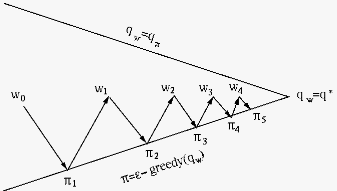Next: Deep Q-learning Up: Introduction to Reinforcement Learning Previous: Value Function Approximation
The control algorithms based on approximated value functions also follow the general method of the general policy iteration, as illustrated bellow:

We note that this is similar to the algorithms for model-free
control illustrated in Fig. 1.4, but with
the action-value function



 is the feature vector for the
state-action pair
is the feature vector for the
state-action pair  . We need to find the optimal
parameter
. We need to find the optimal
parameter  that minimizes the objective function,
the mean square error of the approximation:
with gradient vector:
that minimizes the objective function,
the mean square error of the approximation:
with gradient vector:
 |
 |
![$\displaystyle \frac{d}{d{\bf w}}J({\bf w})
=-E_\pi\left[q_\pi(s,a)-\hat{q}(s,a,{\bf w})\right]
\triangledown\hat{q}(s,a,{\bf w})$](img440.svg) |
|
 |
![$\displaystyle -E_\pi\left[(q_\pi(s,a)-{\bf w}^T{\bf x}(s,a)){\bf x}(s,a)\right]$](img441.svg) |
(96) |
 , instead of
its expectation, then
, instead of
its expectation, then  can be dropped, and the optimal
weight vector
can be dropped, and the optimal
weight vector  that minimizes
that minimizes
 in
Eq. (95) can be learned
iteratively:
in
Eq. (95) can be learned
iteratively:
 is the increment of the update:
is the increment of the update:
 |
 |
![$\displaystyle \alpha[ q_\pi(s_t,a_t)-\hat{q}_\pi(s_t,a_t,{\bf w})]
\triangledown\hat{q}_\pi(s_t,a_t,{\bf w})$](img447.svg) |
|
 |
![$\displaystyle \alpha[ q_\pi(s_t,a_t)-{\bf w}_t^T{\bf x}(s_t,a_t) ]
{\bf x}(s_t,a_t)$](img448.svg) |
(98) |
 in the expression
is unknown, it needs to be estimated by some target
depending on the specific methods used:
in the expression
is unknown, it needs to be estimated by some target
depending on the specific methods used:
The true


![$\displaystyle \Delta{\bf w}
=\alpha[G_t-\hat{q}(s_t,a_t,{\bf w})]
\triangledown \hat{q}(s_t,a_t,{\bf w})
=\alpha[G_t-{\bf w}_t^T{\bf x}(s_t,a_t)]{\bf x}(s_t,a_t)$](img449.svg) |
(99) |
The action value function


Following Eq. (71), the TD error is defined as:
 |
(101) |
 |
(102) |
 ) method:
) method:
In the forward-view version of the TD(



![$\displaystyle \Delta{\bf w}
=\alpha[ G_t^\lambda-{\bf w}_t^T{\bf x}(s_t,a_t) ]{\bf x}(s_t,a_t)$](img457.svg) |
(104) |
The backward-view version of the TD(
We first define an eligiibility trace vector which is set to zero at the beginning of the episode, but then decays
 |
(105) |
 |
(106) |
and Eq. (70)
/////
Recall the TD error for the backward view of the
TD(
 |
(108) |
In summary, here are the conceptual (not necessarily algorithmic) steps for the general model-free control based on approximated action-value function:
 as in Eq. (97),
as in Eq. (97),
 -greedy approach as in
Eq. (41)
-greedy approach as in
Eq. (41)
   |
(109) |